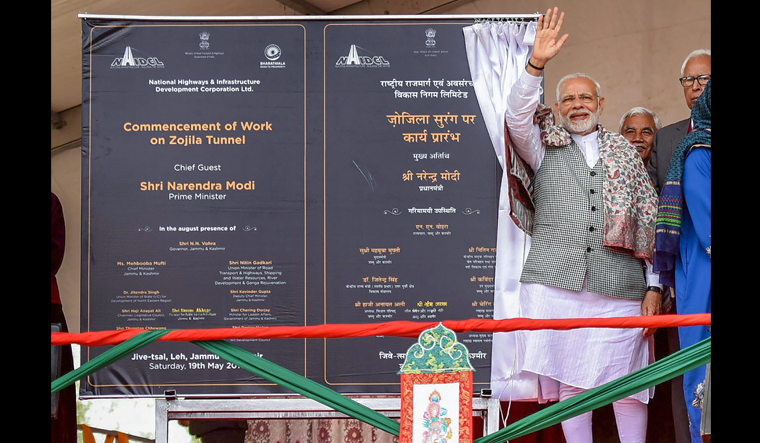Located on the Silk Route, Ladakh, once a majestic region of great strategic importance, has been reduced to a tourist destination in recent decades. Adventure seekers use Ladakh to feed their animal spirit by riding all the way to Khardung La and taking photographs. Others see the place as a platform for their YouTube videos with titles such as My solo trip to Ladakh.
However, with mass tourism, local people are facing a threat to their fragile ecology with tourists zooming past on their Royal Enfields, leaving a cloud of smoke behind. In 2005, officials unveiled the Ladakh 2025 vision document that sought to make the region the country’s best model of hill area development in a challenging environment. Ladakhis couldn't be criticised if they thought they could look forward to a bright future when Thupstan Chhewang of the BJP won the constituency in 2014.
But the land of high passes has received step-motherly treatment at the hands of politicians of all hues and it seems this oft-ignored region of Jammu and Kashmir is tired of broken promises. The recent rout of the BJP in the civic polls in Ladakh has made a point—Ladakh cannot be ignored.
In Ladakh, the BJP failed to win a single ward as the Congress won all 13 seats in municipal committees of Leh and six in Kargil. Seven wards in the region went to independent candidates. In the assembly elections of 2014, the Congress had won the three seats of Leh, Kargil and Nubra. The fourth seat of Zanskar was won by an independent candidate.
The fact that the BJP grew stronger in Kashmir but lost in Ladakh is troubling for the party. Senior BJP leader Ashok Koul was set to leave for Leh on Monday for a brainstorming session. The Congress's gain in Ladakh is an indication that regaining the parliamentary seat in the region will not be an easy task for the BJP.
The promises made
The BJP, in its manifesto in 2014, promised to support Union Territory status for Ladakh, one of the long-standing demands of Ladakhis. The BJP was pitching its win in Ladakh mainly on this point and it was made clear by a speech by Nitin Gadkari ahead of the 2014 polls. No doubt, the demand goes back to 1947, but it doesn't have uniform popular support.
The demand for UT status surfaced from the perception that Ladakh is a Buddhist-dominated region. Because of the insurgency in the Kashmir valley, Ladakh has had to suffer. There is a perception Ladakh is usually denied rights and discriminated against compared with the regions of Jammu and Kashmir. The fact, however, is different. Ladakh has an almost equal percentage of Buddhists and Muslims. The UT status demand was linked to the Buddhist community and thus lacks consensus and popular support. A mere inclusion of this demand in a political campaign is not enough to sustain a majority vote.
The BJP also promised that it would strive for inclusion of the Bhoti language in the Eighth Schedule of the Constitution, but this hasn’t been done until now. Representatives of the Ladakh Buddhist Association reiterated this demand with Governor Satya Pal Malik on his maiden visit to Leh.
Another significant issue for the people of Ladakh is the construction of the Nimmoo-Padum-Darcha road, the early completion of which was promised by the BJP. The only way to reach Zanskar from Leh is via Kargil, a total distance of 470km. In winters, when the road is closed, locals are forced to trek through the frozen Zanskar river, which can often be life-threatening. In such adverse conditions, a road from Nimmoo to Padum is a basic demand for the people. As per the BRO website, 105.30km of road has been developed. The road is expected to be fully functional by 2021.
Other promises made were opening of a Central university in Leh with medical and engineering colleges and opening of Kailash—Mansarovar Road via Demchok for pilgrimage and tourism.
For the Kailash-Mansarovar yatra, there are two main routes for Indian pilgrims. One route passes through Nathu La in Sikkim located at Indo-China border, which was closed last year in the wake of Doklam issue. The other route is through Lipulekh pass in Uttarakhand, which is prone to landslides. However, the shortest and safest route is via Demchok in Ladakh, which has been a site of Chinese intrusions. After the Doklam standoff in 2017, Chinese troops again transgressed over 500m in Demchok in August this year. Without an effective China policy, the government cannot ensure safe passage to the pilgrims via this route.
The BJP manifesto also promised special employment packages, mobile phone connectivity in all rural areas and border villages of Ladakh and increased flight frequency to Leh. On October 5, a delegation headed by Omar Abdullah met Malik and briefed him about the issues faced by people of Ladakh due to poor mobile and internet connectivity and high airfare during winters.
It seems that the political parties have to go a long way to win the trust of people of Ladakh and turn the Ladakh 2025 Vision document into a reality. And the BJP may be the latest to pay a price for failing to fulfil promises.



